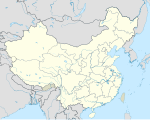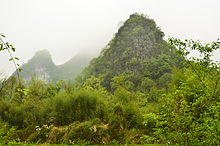Karst landscapes in southern China
Karst landscapes in southern China that have been registered as UNESCO World Heritage |
The karst landscapes in southern China ( Chinese 中国 南方 喀斯特 , Pinyin Zhōngguó Nánfāng Kāsītè ) are evidence of the geological processes that took place in this area in the past geological ages . The karst landscapes extend largely over the provinces of Guangxi , Guizhou , and Yunnan , as well as over the area of the government-direct city of Chongqing . They have impressive natural beauties and some have been included in the UNESCO World Heritage List .
Geological background
About 13% of the area (more than 1.25 million km²) of the area of the People's Republic of China are formed by limestone landscapes. Of this, around 500,000 km² can be characterized as karst landscapes. These karst landscapes are predominantly located in southern China, stretching over about 1380 km in west-east direction and about 1010 km in north-south direction and are mainly in the provinces of Yunnan, Guizhou and Guangxi, but also to a lesser extent in Chongqing , Sichuan , Hunan , Hubei and Guangdong localized. The landscapes have different climatic conditions (humid and semi-arid, subtropical and tropical climates).
From a geological point of view, the limestone ground, some of which is several kilometers thick, emerged in the area of today's southern China in the period from the Cambrian to the Permian , ie around 540 to 250 million years ago. At that time, what is now southern China formed the bottom of a primeval sea in which carbonate and silicate sediments were continuously deposited. This fell as a result of plate tectonic processes that began in the Triassic (200 to 250 million years ago) and led to the gradual rise of the Eurasian plate in this area and the formation of the Himalayas in the late Tertiary (from 70 million years before the present) The sea in the area of southern China was dry and a land mass formed mainly from limestone was created, with an altitude gradient of around 2000 meters falling from northwest to southeast. Under the influence of the erosion caused by the rain and other geological processes (volcanism, etc.), today's extremely diverse karst landscapes with tower karst and conical karst formations, karst caves, sinkholes, etc.
Entry into the UNESCO World Heritage
After the People's Republic of China had initially submitted relatively independent applications for the registration of various karst landscapes in the UNESCO World Heritage, the Chinese government later pursued the strategy of registering the corresponding karst landscapes in southern China in several successive phases as parts of a common world heritage "Karst landscapes in southern China" allow.
A cultural peculiarity of the nominated sites was that they are largely located in regions that are inhabited by national minority peoples (Shilin, Libo and others). During the nomination, the official Chinese government emphasized that the rights of these minorities would be respected and that they would be included in the management and design of the future World Heritage Sites. The rich biodiversity of the nominated sites, in which several rare, strictly protected animal and plant species can be found, was also emphasized.
First nomination phase
In the first nomination phase, the People's Republic of China submitted an application on January 16, 2006 for the registration of three karst landscapes (Shilin Karst in Yunnan, Libo Karst in Guizhou and Wulong Karst in Chongqing) as World Heritage. Shilin Karst and Libo Karst each consisted of two sites, while the Wulong Karst consisted of three sites.
At its 31st meeting in Christchurch ( New Zealand ) from June 23 to July 2, 2007, the UNESCO World Heritage Committee included the seven karst landscapes applied for as UNESCO World Heritage. The reasons given were criteria (vii) and (viii). At the same time, the UNESCO committee suggested that criterion (ix) should also be taken into account.
| ID | Name and place | Place, province | Coordinates | surface | Buffer zone |
|---|---|---|---|---|---|
| 1248-001 | Shilin Karst - Naigu Stone Forest 石林 喀斯特 - 乃 古 石林 |
Shilin , Yunnan |
24 ° 54 ′ 32 " N , 103 ° 21 ′ 13" E | 1,746 ha | 22,930 ha |
| 1248-002 | Shilin Karst - Suogeyicun Stone Forest 石林 喀斯特 - 所 各 邑 村 |
Shilin , Yunnan |
24 ° 43 ′ 4 " N , 103 ° 20 ′ 39" E | 10,324 ha | |
| 1248-003 | Libo Karst - Xiao Qikong 荔波 喀斯特 - 小七孔 |
Libo , Guizhou |
25 ° 16 ′ 38 " N , 107 ° 42 ′ 51" E | 7,834 ha | 43,498 ha |
| 1248-004 | Libo Karst - Dongduo 荔波 喀斯特 - 洞 多 |
Libo , Guizhou |
25 ° 13 ′ 8 ″ N , 107 ° 59 ′ 31 ″ E | 21,684 ha | |
| 1248-005 | Wulong Karst - Qingkou sinkhole 武隆 喀斯特 - 箐 口 天坑 |
Wulong , Chongqing |
29 ° 33 ′ 28 ″ N , 107 ° 59 ′ 10 ″ E | 1,246 ha | 32,000 ha |
| 1248-006 | Wulong Karst - Three natural bridges 武隆 喀斯特 - 天生 三桥 |
Wulong , Chongqing |
29 ° 24 '35 " N , 107 ° 53' 28" E | 2,202 ha | |
| 1248-007 | Wulong Karst - Furong Cave 武隆 喀斯特 - 芙蓉洞 |
Wulong , Chongqing |
29 ° 12 ′ 28 " N , 107 ° 53 ′ 28" E | 2,552 ha | |
| total | 47,588 ha | 98,428 ha | |||
![]() Map with all coordinates of the world heritage components: OSM
Map with all coordinates of the world heritage components: OSM
Second nomination phase
In a second phase, four more were selected from 10 primarily selected karst landscapes by 2012 (Guilin Karst in Guangxi, Shibing Karst in Guizhou and Jinfoshan Karst in Chongqing; in addition, Huanjiang Karst in Guangxi as a direct extension to the Libo Karst) , who were nominated as World Heritage candidates by UNESCO on March 20, 2013. In accordance with the requirements of UNESCO, landscapes were selected that should be complementary to the already registered landscapes, ie should not exactly reproduce their characteristics. The nomination was positively assessed by the responsible committee in April 2014. At its 38th meeting in Doha ( Qatar ) from June 15 to 25, 2014, the sites applied for were included in the World Heritage List by the UNESCO World Heritage Committee.
| ID | Name and place | Place, province | Coordinates | surface | Buffer zone |
|---|---|---|---|---|---|
| 1248-008 | Guilin Karst - Putao-Fenglin 桂林 喀斯特 - 葡萄 峰林 |
Yangshuo , Guangxi |
24 ° 55 '24 " N , 110 ° 21' 16" E | 2,840 ha | 21,610 ha |
| 1248-009 | Guilin Karst - Lijiang Fengcong 桂林 喀斯特 - 漓江 峰丛 |
Yangshuo , Guangxi |
25 ° 0 ′ 8 ″ N , 110 ° 27 ′ 32 ″ E | 22,544 ha | 23,070 ha |
| 1248-010 | Shibing Karst 施秉 喀斯特 |
Shibing , Guizhou |
27 ° 10 ′ 16 " N , 108 ° 5 ′ 40" E | 10,280 ha | 18,015 ha |
| 1248-011 |
Jinfoshan -Karst 金 佛山 喀斯特 |
Nanchuan , Chongqing |
29 ° 0 ′ 30 " N , 107 ° 11 ′ 59" E | 6,744 ha | 10,675 ha |
| 1248-012 | Huanjiang Karst 环 江 喀斯特 |
Huanjiang , Guangxi |
25 ° 10 ′ 1 ″ N , 107 ° 59 ′ 40 ″ E | 7,129 ha | 4,430 ha |
| total | 49,537 ha | 77,800 ha | |||
![]() Map with all coordinates of the world heritage components: OSM
Map with all coordinates of the world heritage components: OSM
Web links
- Karst landscapes in southern China on the UNESCO World Heritage Center website ( English and French ).
Individual evidence
- ↑ Nomination file 1248 (63 MB). Ministry of Construction of the People's Republic of China / UNESCO website, April 2006, pp. 2ff , accessed on July 29, 2019 (English).
- ↑ a b Advisory Body Evaluation (IUCN). UNESCO website, April 2006, accessed on July 30, 2019 .
- ↑ Nomination file 1248 , pp. 21/22: Chinese policies on minority peoples
- ↑ Nomination file 1248 , pp. 41-45: 2.a-2-4 Biotic Community and Biology Species ; Pp. 63–64: 2.a-3-4 Ecosystem , pp. 65–76: 2.a-3-4a Biodiversity ; Pp. 100-104: 2.a-4-4 Biology
- ↑ Decisions: 31COM 8B.11 - Nomination of natural, mixed and cultural properties to the world heritage list - South China Karst. UNESCO website, July 21, 2007, accessed on July 29, 2019 .
- ↑ Nomination file 1248 , Table 1–2: Area of the Nominated Property and Proposed Buffer Zones in the appendix
- ↑ Nomination file 1248bis (195 MB). Ministry of Construction and Urban-Rural Development of the People's Republic of China / UNESCO website, 2013, pp. III, IV, V , accessed on July 29, 2019 (English).
- ↑ a b Advisory Body Evaluation (IUCN). UNESCO website, April 2014, accessed on July 30, 2019 .
- ↑ WHC-14 / 38.COM / 16. (pdf) UNESCO, July 7, 2014, accessed on July 30, 2019 .







